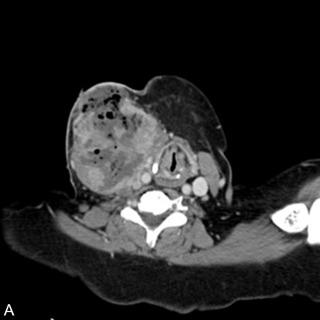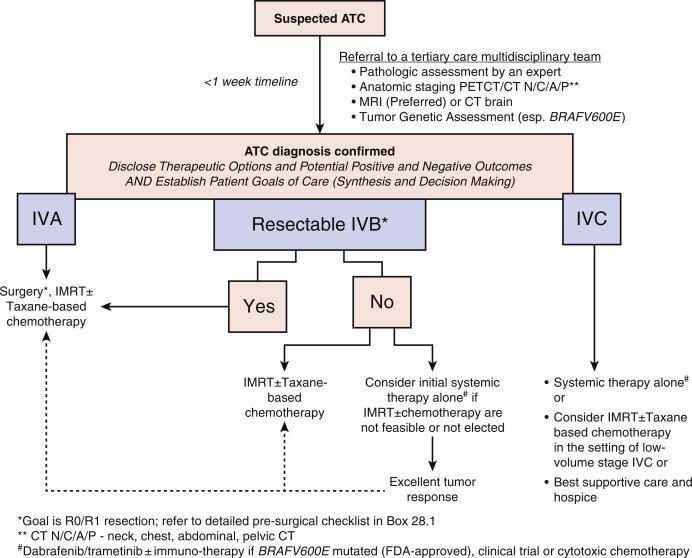Physical Address
304 North Cardinal St.
Dorchester Center, MA 02124
Thyroid cancer incidence is rising rapidly, mostly due to increasing rates of incidentally detected papillary microcarcinoma. Anaplastic thyroid cancer (ATC), however, is a rare form of undifferentiated thyroid carcinoma. Even though the incidence for differentiated thyroid cancer (DTC) is increasing, the incidence for ATC has largely been similar over the years. Overall mortality from DTC is low at ~ 3%, but ATC disproportionately accounts for ~ 20% to 50% of all thyroid cancer deaths, as ATC is highly lethal with median survival reported at 3 to 6 months. On the contrary, primary thyroid lymphoma (PTL) tends to be highly responsive to treatment and thus may have a much better prognosis. This chapter reviews the clinical management of aggressive thyroid tumors, specifically ATC and PTL, which present similarly.
Most patients with aggressive thyroid cancers present with a rapidly enlarging neck mass ( Figure 28.1 , A ). This is often associated with hoarseness, pain or discomfort in the neck, and occasionally erythema of the overlying skin. Other symptoms such as stridor, dysphagia, shortness of breath, or occasional bleeding also occur. In occasional cases, aggressive thyroid cancers are alternatively diagnosed incidentally after thyroidectomy for biopsy-proven DTC.

It is critical to evaluate patients with aggressive thyroid malignancy rapidly. This is best accomplished by a multidisciplinary team at a tertiary cancer center. Initial evaluation should include a careful history, including autoimmune thyroid disease such as Hashimoto’s and DTC, family history, and full physical examination to assess the clinical status of the patient. Airway/vocal cord/upper aerodigestive status should also be assessed by endoscopic examination by an experienced clinician. Although patients may have a large mass causing tracheal deviation or compression of other critical structures such as neck vessels, most patients will not require emergent tracheostomy to maintain the airway. As a rule, guidelines from the American Thyroid Association (ATA) do not recommend routine tracheostomy in these patients but instead only in response to an imminent threat. However, there will be some patients who may require this at initial evaluation, due to impending airway compromise.
Radiographic imaging evaluations for these patients should include a contrast enhanced computed tomography (CT) scan of the neck, chest, abdomen, and pelvis, or alternatively, a whole-body fluorodeoxyglucose-positron emission tomography (FDG-PET) CT. Thyroid FDG uptake on the PET scan is usually very intense in high-grade lymphoma and ATC and is associated with necrosis in some patients (see Figure 28.1 , B ). Unlike DTC, neck sonography alone has a limited role in these patients, due to limited evaluation of disease posterior to and/or invading the trachea. There is also no role for radioactive iodine in ATC except in cases with a dominant DTC tumor metastatic component requiring therapy itself with radioactive iodine. Imaging of the brain to rule out intracranial metastases is recommended in ATC. This comprehensive evaluation should be completed within a few days so that emergent treatment can be started based on the disease pathology, extent, and patient goals of care. Otherwise, these rapidly growing cancers could soon become life threatening to the patient due to delays.
The role of expert pathologic evaluation cannot be overestimated when evaluating tissue from a rapidly growing neck mass. An accurate, and at the same time, expeditious diagnosis is required to facilitate prompt management. Fine-needle aspiration (FNA) can be helpful in establishing diagnosis, but core biopsy is preferred because morphologic analysis on FNA can be inadequate. FNA cellularity can also vary depending on the diagnosis and extent of tumor necrosis. Additionally, FNA might be inadequate if the diagnosis is uncertain and if additional immunohistochemical stains are required.
ATC can sometimes be difficult to distinguish from PTL, sarcoma, medullary thyroid cancer (MTC) or, in extremely rare cases, primary thyroid squamous cell carcinoma. However, morphology and lymphoid markers can initially differentiate lymphomas, including large cell lymphoma, from ATC. Metastatic adenopathy from upper aerodigestive tract malignancies may also present with rapidly enlarging neck masses. Poorly differentiated cancers also tend to lose immunohistochemical staining for nearly all but cytokeratin markers, often making it difficult to distinguish ATC from metastatic cancers from other sites. In this regard, PAX-8 staining is usually positive in ATC and can point to the increased likelihood of thyroid tumor origin, as can association with adjacent DTC.
If distant disease is present at diagnosis, biopsy of that lesion will help to determine accurate staging, as sometimes metastatic DTC and ATC coexist. If the thyroid is involved in a widespread lymphoma, biopsy from a most easily accessible region with prominent FDG activity on PET CT may help optimally target the biopsy. Once the diagnosis is deemed accurate and agreed upon, treatment is directed by specific pathology. Next we discuss ATC and PTL in detail; specific treatments for squamous cell carcinoma, sarcoma, or MTC are not discussed in this chapter.
The American Joint Committee on Cancer (AJCC) 8th edition has modified ATC staging (see chart) with T designations now being consistent with DTC T designations. The overarching similarity from past AJCC ATC staging, however, should be noted in that all ATC are stage IV:
Stage IVA represents intrathyroidal
Stage IVB is associated with gross extrathyroid extension or nodal disease
Stage IVC implies distant metastasis
| ATC AJCC 8th Edition Staging | |||
|---|---|---|---|
| T1-T3a | N0/NX | M0 | —Stage IVA |
| T1-T3a | N1 | M0 | —Stage IVB |
| T3b | Any N | M0 | —Stage IVB |
| T4 | Any N | M0 | —Stage IVB |
| Any T | Any N | M1 | —Stage IVC |
ATC comprises only 1% to 2% of all thyroid cancers but is highly lethal and almost universally fatal. The incidence of ATC is largely stable or increasing at a very slight rate. ATC tends to be a disease of the elderly, with a median age of 60 to 65 years and a female preponderance observed in population-based studies. Rarely, ATC can present in younger patients in the second or third decades of life. There are no clear regional differences in the incidence of ATC, and there is conflicting evidence about the role of iodine deficiency and supplementation in its pathogenesis.
FNA in ATC is usually cellular and mixed with acute inflammatory cells. Open biopsy is often not required, but core biopsy is sometimes needed for architectural details and to facilitate additional stains and/or genomic interrogation. Occasionally, ATC is diagnosed incidentally upon evaluation of a surgical pathology sample from a patient in whom DTC was presumed and ATC and DTC commonly coexist. ATC is usually characterized by minimal to no staining for thyroglobulin, calcitonin, and thyroid transcription factor-1 (TTF-1) but may show robust P53 and PAX8 staining. ATC may stain also for cytokeratin and may show focal staining for vimentin, especially in morphologic variants with spindle cells. ATC has different morphologic variants, such as sarcomatoid, squamoid, osteoblastic, paucicellular, rhabdoid, and carcinosarcoma variant, confounding morphologic assessment, and classification is not always possible on FNA analysis. These different morphologic variants do not affect clinical management.
Nearly half of ATCs show coexistent DTC. It is now well known that a large proportion (25% to 41%) of ATCs carry the BRAFV600E mutation, suggesting origination from preexisting papillary cancers that commonly carry this alteration. Additional genetic alterations occur in ATC, including P53 (29% to 73% of ATCs) and TERT promoter (54% to 73% of ATCs), which have the potential to be associated with incremented mutational burden. Other mutated genes in ATC are seen in the PI3-kinase pathway (PIK3CA, PTEN) , as cell cycle regulators (CDKN2A/2B) , methyltransferases (KMT2A, 2C, 2D) , and involved in mismatch repair deficiency (MSH2, MSH6) . Also, ATCs have been shown to be infiltrated with immune cells, such as tumor-associated macrophages and neutrophils, and have high expression of PD-L1, suggesting a stimulated but restrained immune microenvironment.
ATC has a dismal prognosis. In a population-based study from British Columbia, almost all patients not referred for treatment died within 1 month; 1 year overall survival was 19%. In 1961 Woolner et al. reported from the Mayo Clinic that 61% were dead within 6 months, and 77% within 1 year of diagnosis. Almost 50 years later, a study from MD Anderson reported a mean survival of 7 months. Only 8% (20 of 240 patients) from both series survived longer than 1 year. Median survival in a later Mayo Clinic series was only 3 months. Although improvements have been shown in specific publications, population-based studies continue to show poor prognosis even today. In a National Cancer Database (NCDB) study from 2017, 1-year survival was still dismal at 11%.
If left untreated, death occurs most commonly from the effects of local tumor invasion, particularly asphyxiation, with over half of patients dead from suffocation from an invasive neck tumor. However, in most recent studies, wherein patients were treated with chemoradiation therapy with or without surgery, patients died primarily from distant metastases, suggesting progress in affecting locoregional tumor control.
In single institutional studies, the presence of a DTC component, younger patient age, and earlier tumor stage at the time of diagnosis have been associated with a better prognosis. In a study of 516 patients from the Surveillance, Epidemiology, and End Results (SEER) database, multivariate analysis showed that only age < 60, lesser disease extent, and combined modality therapy with surgical resection and external beam radiotherapy were independent prognostic factors. In the recent NCDB study, age, presence of distant metastasis, administration of chemotherapy, surgical resection, and radiation dose were similarly shown to be independently associated with survival per multivariable analysis. In summary, younger age, limited stage disease (AJCC stage IVA and IVB), and multimodality treatment seem associated with better survival.
Most centers of excellence specifically expedite the care of ATC patients. Effective management mandates focusing on the initially most imminently threatening tumor component, namely the ATC. Treatment of concomitant DTC is put aside until ATC is effectively treated as long as a differentiated tumor does not involve vital structures or is specifically responsible for significant morbidity. In most cases there is no role for radioiodine in the treatment of ATC as ATC is radioactive iodine insensitive. With all due haste, the multidisciplinary treatment team should be assembled (surgery, medical oncology, endocrinology, radiation oncology, and palliative care specialists) to consider treatment options for patients with regard to their disease and clinical status. A meeting with patients and their families should follow, providing full disclosure of the risks and benefits of possible treatment options, including innovative therapy, experimental protocols, and palliative care. Irrespective of available options, every patient’s goals of care must guide therapy election. An overview of our approach to a suspected ATC patient is depicted in Figure 28.2 .

Initial assessment of ATC patients should be performed by a multidisciplinary team comprehensively and rapidly. Any unnecessary delay in assessment may permit ATC to progress from potentially resectable to unresectable and imminently threatening. To assess whether a patient is a candidate for surgical resection is complicated due to the inherent complexities of the disease and technical challenges and compromises associated with resection. Box 28.1 enumerates the steps to be considered before a patient is considered for surgical resection.
| Immediate airway evaluation | Yes | No |
| Stridor—Immediate tracheostomy required ? | □ | □ |
Become a Clinical Tree membership for Full access and enjoy Unlimited articles
If you are a member. Log in here